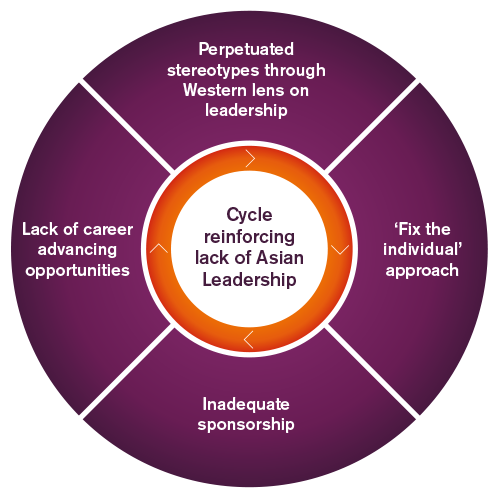![]()
All week, Martin has been thinking about his conversation with his Hong Kong colleague Tina about identifying his successor in Singapore before he returns to Amsterdam. While his first choice was his friend from back home, Thomas, Tina’s questions and nudges to consider Li Shan has got him thinking. Tina was right – Li Shan is not just great at her job, but also a good leader to her team, well-networked and trusted. And while she tends to be quiet during calls, she does speak up when she has something important to say, unlike Martin himself who fills the silence with small talk. When Martin wondered whether if Li Shan has enough gravitas, Tina was quick to point out to him that what he sees as ‘gravitas’ is often code for ‘act like a Western White Man’. He realizes that this decision needs more data and perhaps more flexibility and personal investment from him and other leaders in the global team than what has been happening so far. He decides to speak to Li Shan about her interest in this role and whether she might like to meet some of his counterparts in other countries to learn more about what the role requires. He also calls HR to review Thomas’s and Li Shan’s recent performance records and 360s. The more he reflects on the data and the more he talks to others, the more local names he comes up with as potential leaders for this role and others. After Li Shan speaks to Martin, she decides to politely decline the meeting with the recruiter who’s been chasing her recently – it looks like there is a future for her in this company after all.
Why is this breakthrough important for Martin and his organization’s approach to leadership development and succession planning? What other pieces of the puzzle might Martin be overlooking? What insight and data might help him decide between Thomas and Li Shan – beyond his remembered impressions or subjective judgments? What kinds of organizational support would help break the cycle and unleash the potential of overlooked leaders like Li Shan?
Missed Opportunities
Asia is a growth market for many global companies, one that is growing in financial power and innovation. In many countries, including the mature G7 economies, GDP growth has halved to 1% per year since the 2008 global financial crisis1, but some Asian countries have been consistently growing at higher rates. As a result Asian talent is also growing in capability and ambition – they are no longer merely following the global culture, but increasingly influencing it. With this clear demand and supply – it seems puzzling that so many global organizations are still running their Asian operations with non-Asian leaders and also have little representation of Asian leaders on global teams.
As we outlined in Part 1 of this series, not having sufficient Asian leadership represented in local and global leadership roles poses a strategic risk for business locally and globally. There’s also a talent risk for organizations – as Western expatriates leave Asia in record numbers2 due to restrictive pandemic conditions and also geopolitical considerations (such as new regulations in Hong Kong) there is a growing vacuum of local leaders in Asia. Asian leaders are assumed to be ‘less ready’ for strategic and global leadership roles, which results in less of an investment in developing and advancing them, which in turn leads to them being further overlooked for opportunities. Our data show that there is no difference in leadership potential between Asian and non-Asian leaders, and yet, this reinforcing cycle emerges, that maintains the imbalanced/unfair status quo and exacerbates the impact of these missed opportunities for individuals and organizations. For all these reasons and more, the time for global organizations to invest in Asian leadership is now.

But this is not an easy task. It requires taking a systemic view that sees not only the local Asian leaders but also the global senior leadership as responsible for understanding this reinforcing cycle and breaking it. Local leaders are not the only ones that need to be ‘ready’. The system and the culture need to be ‘ready’ too. Taking a bottom-up approach is not enough, a top-down approach has to exist as well to deliver the needed change. And it’s the combination of the two that will differentiate success from failure in moving the dial.
The Role of Senior Regional and Global Leadership
Organizations and leaders that are successfully negotiating this challenge are doing two things well. First, like Martin, they are engaging in introspection to understand the cycle, to recognize and name the biases that underlie this vicious cycle – biases within individuals and within systems. Second, and following naturally from the first, this involves taking an eco-system view to break the cycle. Based on our research and our work with clients, we have identified the following areas for action.
Understand the cycle: Awareness, Reflection and Planning
Identify the Bias
Global leaders who are truly intentional about this change have learned to avoid falling prey to conformity biases that perpetuate stereotypes and myths about what ‘good’ global leaders look or sound like. They are aware of their blind spots and their own power and privilege, seek out styles that are different than their own, and question their decision making to better separate bias from useful information. Such leaders and organizations also use aggregate data and comparisons to surface systemic biases. They focus on measuring change and articulating a vision for the change, and also openly seeking examples and data that question their complacency and assumptions. It is only when Martin started pulling up HR data, and reviewing Li Shan’s performance based on Tina’s questions and nudges, did he realize the bias he was operating under; the same bias that made him overlook Li Shan’s leadership qualities because they manifested differently compared to his own.
Articulate the Case for Change
Many leaders understand the urgent need to focus on advancing local Asian leadership – but they have not been able to connect the dots between their values and beliefs on inclusion and their actions as a business leader. This requires them to frame what this intentionality means for their business and why this is a business imperative and opportunity for them, not just a ‘nice-to-have’. Only when Martin recognized Li Shan’s extensive network and ease with her team and clients, that he realized that someone like Thomas would actually present a risk to the business since he’d need to start from scratch there. We facilitate conversations with leadership teams to help them design a journey of change for the organization that is not only purposeful but also commercialy relevant and linked directly to the business goals they are trying to achieve.
Break the cycle: Conscious and Committed Action
Shape an Ethnically Inclusive Culture
Senior leaders set the tone for how people in the organization will behave, for what is acceptable and
what is not. Their leadership behaviors will be visible across the ranks and geographies. Leaders who are deliberate about their behaviors and actively signal the change they want to see are more likely to be successful in building an ethnically inclusive culture. They can use visible signals, like role modeling openness and vulnerability and acknowledge their own bias. They can also act as allies and courageously call out bias when it pops up in others (like Tina did for Martin). For leaders to become effective culture carriers and shapers they must be willing to break the cycle, question their internalized (Western) assumptions of leadership and courageously invite feedback and challenges to their decisions.
Sponsor and Advocate for Local Leaders
Global and influential leaders who become vocal and proactive advocates for Asian talent, and commit to actively sponsoring them, can make all the difference in the positioning Asian leaders deserve. Leaders like Tina (and Martin, eventually!) can prove to be critical as effective sponsors who provide local talent with stretch assignments, experience and global visibility. Formal sponsorship programs can enable leaders to go through the journey together, learn from each other and provide support on the way. They help leaders become comfortable in articulating their own commitment and link that to their individual sense of purpose as leaders. When leaders commit to getting results on the ground in the form of advancing specific individuals, they are able to move the dial faster. This breaks the cycle – as more local Asian leaders are promoted to senior roles, it is seen less as an exception and more as the organisational norm.
![]()
The Role of Local Asian Leaders
We are wary of the ‘fix the individual’ approach which ends up blaming historically marginalized and underrepresented groups for their lack of representation in the workforce and leadership cadres. Instead, we propose a holistic approach which includes supporting the individuals from these groups – but also addresses the systems to enable a more inclusive environment for everyone to succeed.
Having said that, Asian leaders themselves – like all leaders – can benefit from support on their career advancement journeys to help recognize the cycle and be prepared to counter those forces.
- By going beyond their personal story, and seeing the system they operate in, leaders can become more aware of the complex reinforcing cycle, and thus, prepared for it.
- Emerging Asian leaders often have had limited experience with working outside their country, and thus, limited sense of where the power centers are and how to influence them. They can intentionally seek support in identifying ways in which they can navigate this complexity, with nuance and intention.
- Leaders would also benefit from support in planning their career progression, close any skill and experience gaps, and build self-advocacy and global visibility.
Finally, let us acknowledge that the cycle we are trying to address here has emerged over long periods of time – and so it is unrealistic to imagine that it will be broken overnight. Taking a systemic, long-term approach, having a clear vision of change and monitoring progress is important. By understanding the patterns, and equipping leaders to challenge and break these patterns, organizations can take important, turnkey steps in accelerating the progress of Asian leaders – at home and globally.
1World Economic Outlook Database, October 2021, International Monetary Fund, imf.org.
Download a copy of the paper here.

